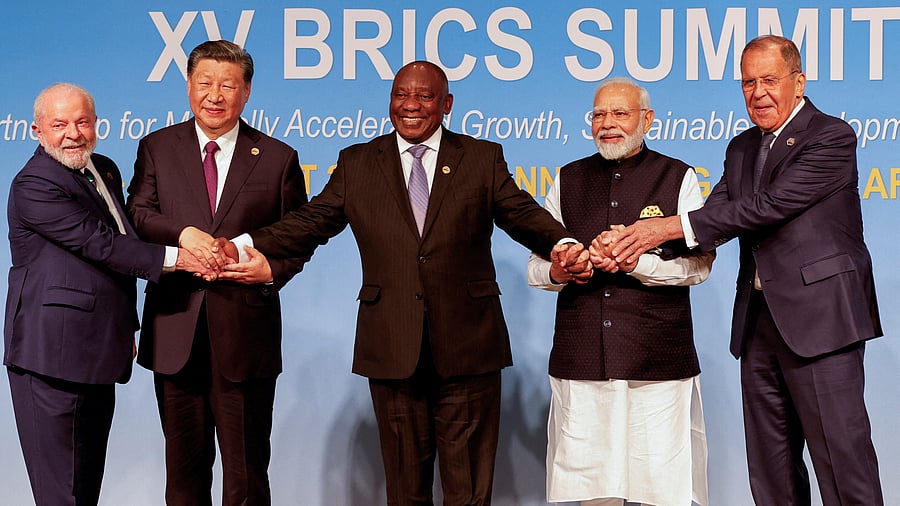
BRICS Summit in Johannesburg
Credit: Reuters Photo
When Prime Minister Narendra Modi attends the 16th BRICS Summit in Kazan, Russia, he will outline India’s vision to an expanded organisation at a new crossroad. Will Brazil, Russia, India, China, and South Africa (BRICS) prioritise growth in emerging economies and support the Global South’s quest for reforms in global governance; or will it be mired in contestation between the West and Russia-China; or could some countries seek a dominant position, undermining BRICS’ consensus-based strength? India’s role will be crucial as BRICS navigates uncharted waters.
Much has changed since the informal meeting of BRIC leaders on the sidelines of G8 Outreach in 2006 in St Petersburg and its first formal summit in 2009 in Yekaterinburg. Consultation on regional and global issues at leader and ministerial levels and practical cooperation on security, development, and civil society sectors provided tangible benefits to BRICS citizens. It attracted the attention of other developing countries who wished to join the dynamic club and also the West, which saw it as competition for the G7.
BRICS surpassed the G7 in gross domestic product, growth rate, critical resources, and population. While geo-economics shifted towards Asia, reforms in global governance did not follow. BRICS made adjustments to secure greater economic and diplomatic space but did not subscribe to the notion of power blocs or alliances. Today, with conflicts and tensions not only in Europe and West Asia but also in the South China Sea and competition pitching one side against the other, the possibility of confrontation appears more likely than before.
The Kazan Summit will undoubtedly discuss global challenges, though consensus on geopolitics is often difficult. BRICS Foreign Ministers who met on the margins of the United Nations General Assembly did not issue a joint statement, and even the UN Summit of the Future achieved weak consensus on global reforms. But there is confidence that in Kazan, the expanded BRICS community will find common ground on development and seek reforms in global governance.
BRICS has evolved from its earlier focus on internal consolidation to doubling its membership at the Johannesburg Summit based on agreed criteria, aiming for new synergies and broader regional representation. Modalities have also been initiated to create guidelines for a second tier of partner countries. With greater regional representation, shared objectives, and economic ambition, these new members could add to BRICS’ dynamism.
Concerns have been raised that BRICS+ could become unwieldy or anti-West. However, the BRICS ethos makes it unlikely that the group will follow the lead of a single country or adopt an adversarial stance toward those outside the group. Given the global situation’s volatility, BRICS may take a modest approach in its declarations or peace-making initiatives. Still, its expansion will likely
be a positive factor for peace and stability.
Reform of global governance, particularly of UN, UNSC, and Bretton Woods institutions, was expected as a corollary to intra-BRICS cooperation and a more empowered and aspirational Global South.
When the response of old powers on reform of global governance was tepid, BRICS initiated measures and established institutions to bring equity. However, reform of global governance can happen only at the multilateral level. On reform of UN and particularly of UNSC, the position of one of the founding members of BRICS has not been helpful; on World Bank, IMF, WTO, or WHO, the reluctance of many other players had also come in the way of much-needed reforms.
The voice of the Global South and the overlap of aspirations and concerns of BRICS and G7 in the bridge formed by G20 marked progress. In the absence of meaningful reforms, many countries will continue to rely on their own resources and on plurilateral efforts to achieve their objectives.
The success of BRICS was most noteworthy in its development agenda. That thrust is likely to continue. Pragmatic mechanisms helped boost trade and investment; the New Development Bank provided funds to developing countries; joint projects supported technology transfers; and harmonisation efforts built supply chains and access to energy and critical materials. Intra-BRICS cooperation grew rapidly and is poised for higher momentum.
For almost a decade, BRICS promoted trade in local currencies, and there is new vigour today. Finance ministers proposed new instruments for countertrade, barter, digital transactions, reserve currency, and alternate financial settlement mechanisms. Some even sought a BRICS currency, which may be somewhat premature, but intermediate solutions based on trade value or weighted currency indices could provide efficiency. While western sanctions on certain countries may have played a role, the development of new competencies in BRICS will have a far-reaching impact on financial flexibility and their development agenda.
The weight of BRICS is poised to grow as BRICS members expand spheres of influence. In a multipolar world, cooperative mechanisms provide mutually beneficial and sustainable global solutions. India’s role in BRICS, G7 Outreach, and G20 provides her dynamic economy and vibrant democracy as a factor for a shared and inclusive future for humanity.
(The writer is former BRICS Sherpa during India’s Presidency in 2021 and Professor of Diplomatic Practice at Jindal Global University)